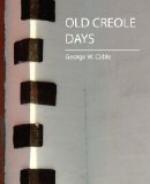However, as you begin to find the way a trifle more open, you will not fail to notice on the right-hand side, about midway of the square, a small, low, brick house of a story and a half, set out upon the sidewalk, as weather-beaten and mute as an aged beggar fallen asleep. Its corrugated roof of dull red tiles, sloping down toward you with an inward curve, is overgrown with weeds, and in the fall of the year is gay with the yellow plumes of the golden-rod. You can almost touch with your cane the low edge of the broad, overhanging eaves. The batten shutters at door and window, with hinges like those of a postern, are shut with a grip that makes one’s knuckles and nails feel lacerated. Save in the brick-work itself there is not a cranny. You would say the house has the lockjaw. There are two doors, and to each a single chipped and battered marble step. Continuing on down the sidewalk, on a line with the house, is a garden masked from view by a high, close board-fence. You may see the tops of its fruit-trees—pomegranate, peach, banana, fig, pear, and particularly one large orange, close by the fence, that must be very old.
The residents over the narrow way, who live in a three-story house, originally of much pretension, but from whose front door hard times have removed almost all vestiges of paint, will tell you: “Yass, de ’ouse is in’abit; ’tis live in.”
And this is likely to be all the information you get—not that they would not tell, but they cannot grasp the idea that you wish to know—until, possibly, just as you are turning to depart, your informant, in a single word and with the most evident non-appreciation of its value, drops the simple key to the whole matter:
“Dey’s quadroons.”
He may then be aroused to mention the better appearance of the place in former years, when the houses of this region generally stood farther apart, and that garden comprised the whole square.
Here dwelt, sixty years ago and more, one Delphine Carraze; or, as she was commonly designated by the few who knew her, Madame Delphine. That she owned her home, and that it had been given her by the then deceased companion of her days of beauty, were facts so generally admitted as to be, even as far back as that sixty years ago, no longer a subject of gossip. She was never pointed out by the denizens of the quarter as a character, nor her house as a “feature.” It would have passed all Creole powers of guessing to divine what you could find worthy of inquiry concerning a retired quadroon woman; and not the least puzzled of all would have been the timid and restive Madame Delphine herself.
CHAPTER II.
MADAME DELPHINE.




